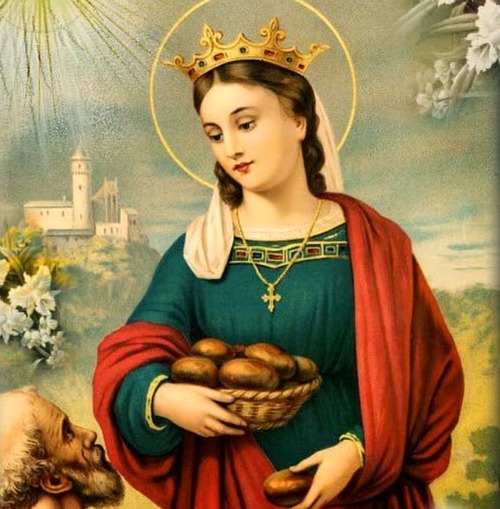St. Elizabeth of Hungary
| Feast day | September 25 |
| Patron | of Cork, Diocese of Cork |
| Birth | 550 |
| Death | 620 |
St. Elizabeth of Hungary, also known as St. Elizabeth of Thuringia, was born in Hungary on July 7, 1207 to the Hungarian King Andrew II and Gertrude of Merania.
As soon as her life began, she had responsibilities from being a royal pressed upon her. While Elizabeth was very young, her father arranged for her to be married to Ludwig IV of Thuringia, a German nobleman. Because of this plan, Elizabeth was sent away at the age of four for education at the court of the Landgrave of Thuringia.
Elizabeth’s mother, Gertrude, was murdered in 1213, when Elizabeth was just six-years-old. According to history, the murder was carried out by Hungarian noblemen due to the conflict between Germans and the Hungarian nobles. From this point on, Elizabeth’s perspective on life and death dramatically changed and she sought peace with prayer.
Happiness was returned to her young life in 1221 when she was formally married to Ludwig, whom she deeply loved. Together the couple had three beautiful children, two of whom became members of nobility and the third entering the religious life, becoming abbess of a German convent.
Elizabeth continued to live a life full of prayer and a service to the poor. Ludwig, who was now one of the rulers of Thuringia, supported all of Elizabeth’s religious endeavors even though she was a part of the royal court. She began to lead an austerely simple life, practiced penance, and devoted herself to works of charity. She used her royal position to advance her mission for charity.
In 1223, Franciscan friars arrived in Thuringia and taught 16-year-old Elizabeth all about Francis of Assisi’s ideals. She then forth decided to live her life mirroring his.
She wore simple clothing and set aside time every day to take bread to hundreds of poor people in her land. Ludwig and Elizabeth were politically powerful and lived with a remarkable generosity toward the poor.
In 1226, when disease and floods struck Thuringia, Elizabeth took to caring for the victims. It is said she even gave away the royal’s clothing and goods to the afflicted people. Elizabeth had a hospital built and provided for almost a thousand poor people daily.
Elizabeth’s life was full of love and faith. However, tragedy struck when Ludwig passed away from illness in 1227. It is said upon hearing the news, she said, “He is dead. He is dead. It is to me as if the whole world died today.” His remains were entombed at the Abbey of Reinhardsbrunn.
Elizabeth vowed to never remarry and to live a life similar to a nun, despite pressure from relatives.
Her vows included celibacy and an agreement of complete obedience to her confessor and spiritual director, Master Conrad of Marburg. His treatment of Elizabeth was very strict and often harsh. He held her to a standard that many saw as impossible to meet. He provided physical beatings and sent away her children. However, she continued to keep her vow, even offering to cut off her own nose, so she woud be too ugly for any man to want.
In 1228, Elizabeth joined the Third Order of St. Francis. Elizabeth, having received her dowry, founded a hospital in honor of St. Francis, where she personally attended to the ill. She ministered to the sick and provided support to the poor.
Elizabeth’s life was consumed deeply by her devotion to God and her charitable labor. She passed away at the age of 24, on November 17, 1231 in Marburg, Hesse.
One of her greatest known miracles occurred when she was still alive, the miracle of roses. It is said that during one of her many trips delivering bread to the poor in secret, Ludwig met with her and asked her questions to erase everyone’s suspicions that she was stealing treasures from the castle. He asked her to reveal the contents under her cloak, and as she did a vision of white and red roses was seen. To Ludwig, this meant God’s protection was evident. In other versions, it was her brother-in-law who found her. Elizabeth’s story is one of the first of many that associates Christian saints with roses.
Another living miracle involved a leper lying the bed she shared with her husband. Her mother-in-law discovered Elizabeth had placed a leper in the bed, and feeling enraged, she informed Ludwig. Annoyed with the situation, Ludwig removed the bedclothes and instantly the “Almighty God opened the eyes of his soul, and instead of a leper he saw the figure of Christ crucified stretched upon the bed.”
After her death, miraculous healings began to occur at her graveside near her hospital. Examinations were held for those who had been healed from 1232 to 1235. The investigations, along with testimony from Elizabeth’s handmaidens and companions and the immense popularity surrounding her, provided enough reason for her canonization.
Pope Gregory IX canonized her on May 27, 1235.
St. Elizabeth’s feast day is celebrated on November 17 and she is the patron saint of bakers; beggars; brides; charities; death of children; homeless people; hospitals; Sisters of Mercy; widows.
Elizabeth’s body was laid in a gold shrine in the Elisabeth Church in Marburg. Although the shrine can still be seen today, her body is no longer there. One of her own descendents scattered her remains at the time of the Reformation.
St. Elizabeth is often depicted with a basket of bread to show her devotion for the poor and hungry. She is also painted in honor of the “Miracle of Roses” and “Crucifix in the Bed.”
St. Elizabeth has been praised by Pope Benedict XVI as a “model for those in authority.”
Views: 20
